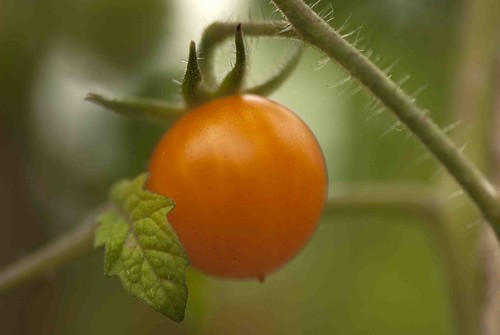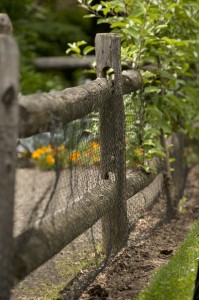Inside The New York Botanical Garden
vegetable garden design
Posted in Exhibitions, The Edible Garden on July 6 2010, by Sonia Uyterhoeven
 |
Sonia Uyterhoeven is Gardener for Public Education. Join her each weekend for home gardening demonstrations on a variety of topics in the Home Gardening Center. |
 Garden writer Sydney Edison studies how great art masters combine color on their canvas and uses those lessons as inspiration for the color combinations in her patio displays. Color in the vegetable garden is equally important. It can transform an ordinary or utilitarian space into a work of art.
Garden writer Sydney Edison studies how great art masters combine color on their canvas and uses those lessons as inspiration for the color combinations in her patio displays. Color in the vegetable garden is equally important. It can transform an ordinary or utilitarian space into a work of art.
Design your vegetable garden with color in mind by paying attention to the color of fruit, flowers, and foliage. A bed of yellow and red peppers can be accentuated by repeating the color with a surrounding edge of marigolds. Scarlet runner beans can climb up vertical structures that will pick up the hot color theme.
Repeating color themes is one of the simplest and most effective ways to both literally and figuratively soup-up your vegetable garden. This can be done with vegetables but also enhanced by colorful herbs and summer annuals that can find their way into a vase on the kitchen table.
Read More
Posted in Exhibitions, Gardening Tips, The Edible Garden on June 28 2010, by Sonia Uyterhoeven
 |
Sonia Uyterhoeven is Gardener for Public Education. Join her each weekend for home gardening demonstrations on a variety of topics in the Home Gardening Center. |
 Last week I blogged about the historic and design aspects of ornamental vegetable gardens. This week I take a look at some of their basic features.
Last week I blogged about the historic and design aspects of ornamental vegetable gardens. This week I take a look at some of their basic features.
Many traditional kitchen gardens have some kind of boundary or enclosure that not only separates the garden from its surroundings but often provides a practical barrier to keep out unwanted pests. Classic boundaries include brick walls, stonewalls, wooden fences, wattle or woven fences, and hedges.
A simple split-rail wooden fence lined with chicken wire to keep out rabbits surrounds the vegetable garden in the Botanical Garden’s Home Gardening Center (see photo). “A flat-top picket fence would give it a Colonial feel, while a more open and rustic setting could be created by a zigzag wooden fence,” says Chris from a fence company in Louisville, KY. The hardscape of the garden will help set the mood and contribute to the overall design. Enclosure creates a sense of intimacy and gives a framework to your garden.
Read More
Posted in Exhibitions, Gardening Tips, The Edible Garden on June 21 2010, by Sonia Uyterhoeven
 |
Sonia Uyterhoeven is Gardener for Public Education. Join her each weekend for home gardening demonstrations on a variety of topics in the Home Gardening Center. |
 While it is commonplace to invest a considerable amount of thought, energy, and pride in the design of our gardens, herbaceous borders in particular, the vegetable garden often gets overlooked and undervalued as a potential site for artistic excellence.
While it is commonplace to invest a considerable amount of thought, energy, and pride in the design of our gardens, herbaceous borders in particular, the vegetable garden often gets overlooked and undervalued as a potential site for artistic excellence.
However, ornamental vegetable gardens have a long-standing tradition. The Persians filled their walled gardens with fruit trees and edible plants, adorning these places of refuge while providing food for the table. The Cloisters Museum & Gardens, a branch of the Metropolitan Museum of Art in Manhattan’s Fort Tryon Park, is a wonderful example of how medieval courtyards were home to the cultivation of culinary and medicinal herbs while providing a place for peaceful retreat.
Inspiration can be found in many historic restorations of ornamental vegetable gardens, ranging from the Grande Potagér at Chateau de Villandry in France to England’s Lost Gardens of Heligan and the walled Victorian kitchen garden at Chilton Foliat. Closer to home, Thomas Jefferson’s historic gardens at Monticello in Virginia celebrate America’s vegetable gardening tradition.
Read More

 Garden writer Sydney Edison studies how great art masters combine color on their canvas and uses those lessons as inspiration for the color combinations in her patio displays. Color in the vegetable garden is equally important. It can transform an ordinary or utilitarian space into a work of art.
Garden writer Sydney Edison studies how great art masters combine color on their canvas and uses those lessons as inspiration for the color combinations in her patio displays. Color in the vegetable garden is equally important. It can transform an ordinary or utilitarian space into a work of art.

